The Girl Who Leapt Through Time (lost build of unreleased PlayStation adventure game based on Japanese novel; 1998): Difference between revisions
m (Grammatical errors.) |
m (→Videos) |
||
| (4 intermediate revisions by one other user not shown) | |||
| Line 5: | Line 5: | ||
|status=<span style="color:red;">'''Lost'''</span> | |status=<span style="color:red;">'''Lost'''</span> | ||
}} | }} | ||
Around 1998, an adventure game entitled "''Toki o Kakeru Shojo''" (''時をかける少女''), or in English and better known as '''''The Girl Who Leapt Through Time''''' was developed by Bandai Namco Games (now renamed to Bandai Namco Entertainment)<ref name="atlas">[https://mnsatlas.com/?p=52426 MNSAtlas.com article on the game.] Retrieved 07 Feb '23</ref> for the PlayStation 1. It was reportedly based around the well-renowned and acclaimed Yasutaka Tsuitsui novel of the same name, "''Toki o Kakeru Shojo''" back in 1967, and conceivably the [https://en.wikipedia.org/wiki/Toki_o_Kakeru_Sh%C5%8Djo_(1997_film) 1997 movie of the same name directed by Haruki Kadokawa] that is also based on Yasutaka Tsuitsui's novel and is one of its many interpreted adaptations on films<ref name="unseen">[https://unseen64.net/2021/07/17/girl-leapt-through-time-playstation-game-cancelled/ Unseen64 article on ''The Girl Who Leapt Through Time''.] Retrieved 07 Feb '23</ref><ref name="atlas" />, on which both the movie and novel follows a young high-school girl who had acquired the oddity to time travel and in doing so, can coerce herself to reiterate and change previous events to have a different outcome due to this | Around 1998, an adventure game entitled "''Toki o Kakeru Shojo''" (''時をかける少女''), or in English and better known as '''''The Girl Who Leapt Through Time''''' was developed by Bandai Namco Games (now renamed to Bandai Namco Entertainment)<ref name="atlas">[https://mnsatlas.com/?p=52426 MNSAtlas.com article on the game.] Retrieved 07 Feb '23</ref> for the PlayStation 1. It was reportedly based around the well-renowned and acclaimed Yasutaka Tsuitsui novel of the same name, "''Toki o Kakeru Shojo''" back in 1967, and conceivably the [https://en.wikipedia.org/wiki/Toki_o_Kakeru_Sh%C5%8Djo_(1997_film) 1997 movie of the same name directed by Haruki Kadokawa] that is also based on Yasutaka Tsuitsui's novel and is one of its many interpreted adaptations on films<ref name="unseen">[https://unseen64.net/2021/07/17/girl-leapt-through-time-playstation-game-cancelled/ Unseen64 article on ''The Girl Who Leapt Through Time''.] Retrieved 07 Feb '23</ref><ref name="atlas" />, on which both the movie and novel follows a young high-school girl who had acquired the oddity to time travel and in doing so, can coerce herself to reiterate and change previous events to have a different outcome due to this acquired "time-looping". | ||
'''The game would be given a Fall 1998 release<ref name="atlas" />, but has remained unreleased, and was likely discontinued'''. Though likely, the game might have been planned to be released around the time of the 30th-anniversary of Yasutaka Tsuitsui's novel being released .<ref name="atlas" /> | '''The game would be given a Fall 1998 release<ref name="atlas" />, but has remained unreleased, and was likely discontinued'''. Though likely, the game might have been planned to be released around the time of the 30th-anniversary of Yasutaka Tsuitsui's novel being released .<ref name="atlas" /> | ||
| Line 23: | Line 23: | ||
==Gallery== | ==Gallery== | ||
===Screenshots (Gameplay)=== | ===Screenshots (Gameplay)=== | ||
<gallery mode=packed heights= | <gallery mode=packed heights=140px> | ||
ThroughTime2.png|Screenshot of the gameplay (1/4) | ThroughTime2.png|Screenshot of the gameplay (1/4) | ||
ThroughTime3.png|Screenshot of the gameplay (2/4) | ThroughTime3.png|Screenshot of the gameplay (2/4) | ||
| Line 30: | Line 30: | ||
</gallery> | </gallery> | ||
===Screenshots (Cutscenes)=== | ===Screenshots (Cutscenes)=== | ||
<gallery mode=packed heights= | <gallery mode=packed heights=125px> | ||
ThroughTime1.png|Screenshot of one of the cutscenes in the game (1/5) | ThroughTime1.png|Screenshot of one of the cutscenes in the game (1/5) | ||
ThroughTime4.png|Screenshot of one of the cutscenes in the game (2/5) | ThroughTime4.png|Screenshot of one of the cutscenes in the game (2/5) | ||
| Line 48: | Line 48: | ||
|id1 =S3KY9q53SSU | |id1 =S3KY9q53SSU | ||
|description1 =YouTube video that includes footage of the gameplay. | |description1 =YouTube video that includes footage of the gameplay. | ||
|service2 = | |service2 =nicovideo | ||
|id2 =sm560110 | |id2 =sm560110 | ||
|description2 =NicoNico video that includes footage of the gameplay. | |description2 =NicoNico video that includes footage of the gameplay. | ||
}} | }} | ||
==Trivia== | ==Trivia== | ||
*Note that the game is not based around the more known 2006 film animated adaptation of the novel, [https://en.wikipedia.org/wiki/The_Girl_Who_Leapt_Through_Time_(2006_film) The Girl Who Leapt Through Time], directed by Mamoru Hosoda and animated by Studio Chizu. Take note that the film's release was in 2006, and this game was planned to be released in 1998. Though as the [https://unseen64.net/beta-and-cancelled-videogames/ Unseen64] article jokingly puts it, "unless Bandai leapt through time"<ref name="unseen" />. | *Note that the game is not based around the more known 2006 film animated adaptation of the novel, [https://en.wikipedia.org/wiki/The_Girl_Who_Leapt_Through_Time_(2006_film) The Girl Who Leapt Through Time], directed by Mamoru Hosoda and animated by Studio Chizu. Take note that the film's release was in 2006, and this game was planned to be released in 1998. Though as the [https://unseen64.net/beta-and-cancelled-videogames/ Unseen64] article jokingly puts it, "unless Bandai leapt through time"<ref name="unseen" />. | ||
Latest revision as of 18:34, 30 November 2023
Around 1998, an adventure game entitled "Toki o Kakeru Shojo" (時をかける少女), or in English and better known as The Girl Who Leapt Through Time was developed by Bandai Namco Games (now renamed to Bandai Namco Entertainment)[1] for the PlayStation 1. It was reportedly based around the well-renowned and acclaimed Yasutaka Tsuitsui novel of the same name, "Toki o Kakeru Shojo" back in 1967, and conceivably the 1997 movie of the same name directed by Haruki Kadokawa that is also based on Yasutaka Tsuitsui's novel and is one of its many interpreted adaptations on films[2][1], on which both the movie and novel follows a young high-school girl who had acquired the oddity to time travel and in doing so, can coerce herself to reiterate and change previous events to have a different outcome due to this acquired "time-looping".
The game would be given a Fall 1998 release[1], but has remained unreleased, and was likely discontinued. Though likely, the game might have been planned to be released around the time of the 30th-anniversary of Yasutaka Tsuitsui's novel being released .[1]
Gameplay
With its gameplay only being based around solely on the existing footage available online, it's hard to have a full grasp of what the game's story is and how it is played, though an MNSAtlas.com article stated that the cancelled game seemed to have taken influence on the 1994 game, "Tokimeki Memorial"[1], a dating-simulator game that was really popular in Japan in the 1990s. The Unseen64 article stated that the game looked similar on the 1996 Playstation 1 role-playing game, "Revelations: Persona", due to its top-down approach and its animated cutscenes insert[2].
The game's character designs and the insert of its animated scenarios were drawn and created by Minene Sakurano, a manga artist who is famous for Mamotte Shugogetten[1][2], and the writer for its animated scenarios insert were made by Hiroshi Yamaguchi[1][2], a writer who had worked on various anime series like Neon Genesis Evangelion and Gurren Lagann[3]. The MNSAtlas.com article on the game cites that the cancelled game featured the voice works from voice actors starring Tomoko Kawakami, Tsuyoshi Kusao, and Taiki Matsuno, though it was unclear which voice actors voiced which characters from the game. Additionally, information about and around the characters in the game is unknown, asides from them being high-school students.
Disappearance & Availability
The game was scheduled to be released in Fall of 1998[1], though this statement was uncited, and the release was later discontinued and went unreleased. It is unknown on how far the game had been completed before it got discontinued, though recently on 2021, Twitter user @jironosuke99 shared a box art for the game on Twitter[4], which suggests that the game must've been far into production before overall discontinuing. Aside from this box art, the game is featured in the 76th volume of the Dengeki PlayStation magazine in June 1998, which was shared by Twitter user @datsuimon on Twitter.[2][5], though the magazine has yet to be translated as of 2022, and if so, will give more information about the game itself.
Footage from the game is scarce as there are only two available videos that feature content from the game online. One is from a Nicovideo from 2007, and another is from 2020 that was uploaded by YouTuber DIY channel of Professor Moriarty. The latter video explained in its description that said footage came from and was included at the 1997 VHS release of the 1997 movie of the same name which was shown in the very beginning of said VHS[6]
As of January 2023, no available playable build of the game is available. Though it has been 20 years since the game had been discontinued, it is unlikely that any prototypes or builds of the game would ever see the light of day[1].
Gallery
Screenshots (Gameplay)
Screenshots (Cutscenes)
Outside Material
The shared box art of the game, from @jironosuke99
Dengeki Playstation magazine advertising the game, from @datsuimon (1/2) [YET TO BE TRANSLATED]
Dengeki Playstation magazine advertising the game, from @datsuimon (2/2) [YET TO BE TRANSLATED]
Videos
Trivia
- Note that the game is not based around the more known 2006 film animated adaptation of the novel, The Girl Who Leapt Through Time, directed by Mamoru Hosoda and animated by Studio Chizu. Take note that the film's release was in 2006, and this game was planned to be released in 1998. Though as the Unseen64 article jokingly puts it, "unless Bandai leapt through time"[2].
References
- ↑ 1.0 1.1 1.2 1.3 1.4 1.5 1.6 1.7 1.8 MNSAtlas.com article on the game. Retrieved 07 Feb '23
- ↑ 2.0 2.1 2.2 2.3 2.4 2.5 Unseen64 article on The Girl Who Leapt Through Time. Retrieved 07 Feb '23
- ↑ Hiroshi Yamaguchi's works portfolio on ANN. Retrieved 07 Feb '23
- ↑ @jironosuke99's tweet on the game's box art Retrieved 07 Feb '23
- ↑ @datsuimon's tweet sharing the Dengeki Playstation magazine advertising the game. Retrieved 07 Feb '23
- ↑ DIY channel of Professor Moriarty's video with the footage of the game with its description explaining its discovery in the 1997 movie VHS release. Retrieved 07 Feb '23
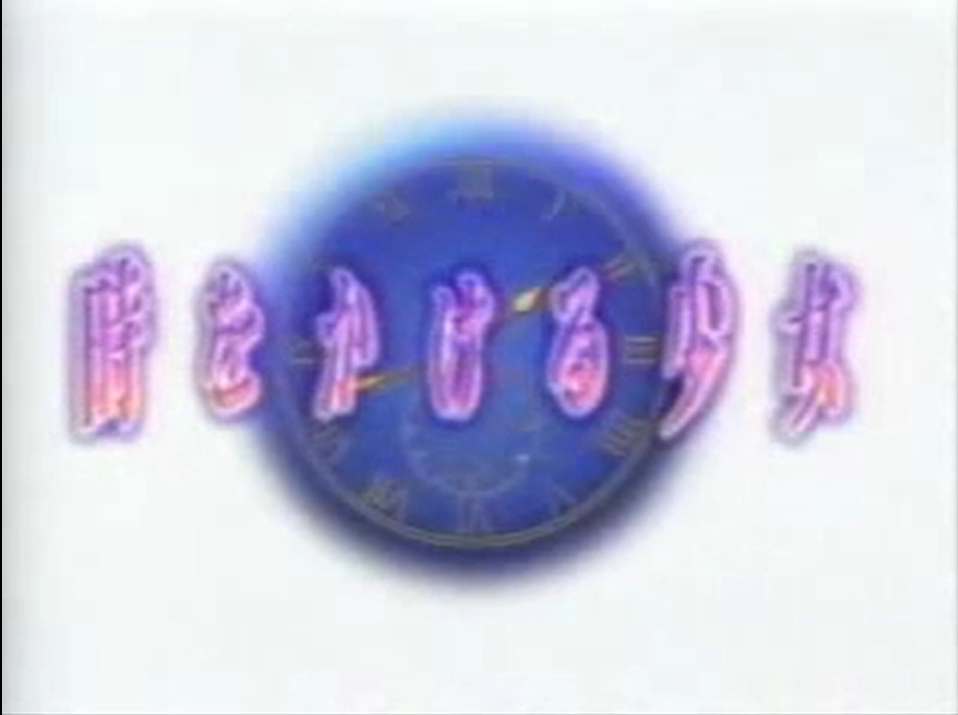
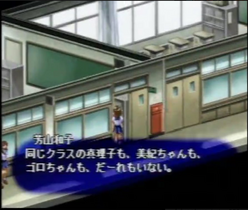
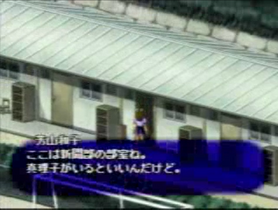
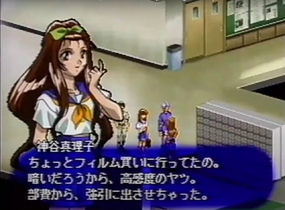
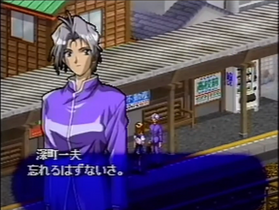
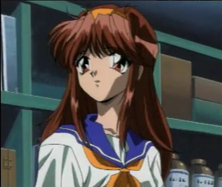
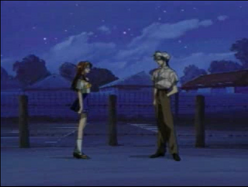
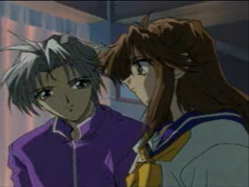
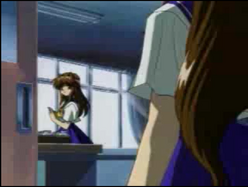
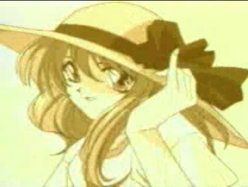
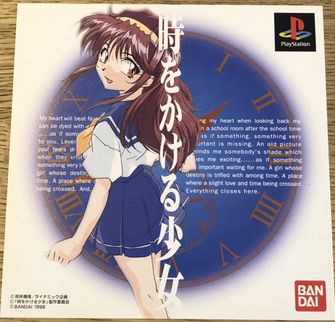
![Dengeki Playstation magazine advertising the game, from @datsuimon (1/2) [YET TO BE TRANSLATED]](/w/images/thumb/2/28/ThroughTimeMAGS1.jpg/430px-ThroughTimeMAGS1.jpg)
![Dengeki Playstation magazine advertising the game, from @datsuimon (2/2) [YET TO BE TRANSLATED]](/w/images/thumb/f/f3/ThroughTimeMAGS2.jpg/430px-ThroughTimeMAGS2.jpg)